 Weird Stuff
Weird Stuff  Weird Stuff
Weird Stuff  Mysteries
Mysteries 10 Tragic Disappearances and Deaths in Joshua Tree National Park
 History
History 10 Ways Childhood Really Sucked in the Old West
 Music
Music 10 Name Origins of Famous Bands from the 1990s
 Religion
Religion 10 Biggest Turnarounds by the Catholic Church
 Weird Stuff
Weird Stuff 10 Unbelievable Times Laws Had Unintended Consequences
 Humans
Humans Ten Historic Women Who Deserve Way More Credit Than They Got
 Movies and TV
Movies and TV 10 Films That Spawned Major Lawsuits
 History
History Ten Times Towns Were Wiped Off the Face of the Earth
 Creepy
Creepy 10 of the Most Disturbingly Haunted Public Houses in the UK
 Weird Stuff
Weird Stuff 10 Niche Subcultures That Are More Popular Than You Might Think
 Mysteries
Mysteries 10 Tragic Disappearances and Deaths in Joshua Tree National Park
 History
History 10 Ways Childhood Really Sucked in the Old West
Who's Behind Listverse?

Jamie Frater
Head Editor
Jamie founded Listverse due to an insatiable desire to share fascinating, obscure, and bizarre facts. He has been a guest speaker on numerous national radio and television stations and is a five time published author.
More About Us Music
Music 10 Name Origins of Famous Bands from the 1990s
 Religion
Religion 10 Biggest Turnarounds by the Catholic Church
 Weird Stuff
Weird Stuff 10 Unbelievable Times Laws Had Unintended Consequences
 Humans
Humans Ten Historic Women Who Deserve Way More Credit Than They Got
 Movies and TV
Movies and TV 10 Films That Spawned Major Lawsuits
 History
History Ten Times Towns Were Wiped Off the Face of the Earth
 Creepy
Creepy 10 of the Most Disturbingly Haunted Public Houses in the UK
10 Punishments Of The Royal Navy During The Age Of Sail
Back in the days of old—before such trivial matters as health and safety regulations, child welfare, or human rights became things to worry about—a captain of one of His Majesty’s finest ships in the British Royal Navy could rule the poop deck (or any part of the ship) with an iron fist.
In the 17th and 18th centuries, the Royal Navy was a harsh place for a sailor—with many punishments meted out for various mistakes or crimes. The lowest punishments would start off as more of a slap on the wrist or a humiliating action, such as watering down the grog, extra watch duties, short lunch breaks, or even being “chastised” by the ship’s boys with wet swabs.
These men were all living together for long times in a cramped area. Severe punishment was generally held back so as not to affect the crew’s morale as a whole. However, as we’re about to find out, things could get much worse.
10 Starting

Many punishments were formal, as in ordered by the captain with a record kept in the ship’s log. The discipline delivered by the boatswain or bosun’s mate (a foreman of sorts) was an on-the-spot thing with no need of a written account. Thus, it could happen for any reason at any time.
The bosun’s mate always carried a small weapon to beat the unfortunate offender. This weapon was usually a knotted rope, small whip, or cane called a “rattan.” Sometimes, three canes were tied together and called the “three sisters.”
These beatings were known as “starting,” as in starting to beat. A bosun’s mate could be ordered to start a man until told to stop. If his arm became tired, another mate would be called to continue the abuse. These bashings were an everyday occurrence aboard a ship.
At any time, a mate could hit an unruly sailor. Unchecked, a sadistic bosun’s mate could and did cause serious harm on many occasions. Ultimately, this led to the beginning of their suppression in 1811.[1]
9 Gagging
This punishment was used when a sailor became a little too lippy or committed other minor offenses. To teach him a lesson, his hands and legs were bound. An iron bolt would be put in his mouth, tied in place from behind his head, and left for whatever time the officer felt fit the crime. If you’ve ever seen the film Pulp Fiction, think of the pool-balls-in-the-mouth scene (shown above).
This was another punitive action not recorded in the logs because it could have dire repercussions. As it was frowned upon by the Admiralty, gagging was never an official punishment. Nevertheless, it was used on numerous occasions.
In 1867, George Addison, a crew member of the HMS Favorite, was gagged for drunkenness and violence. He died from asphyxiation within two hours.[2]
8 Flogging
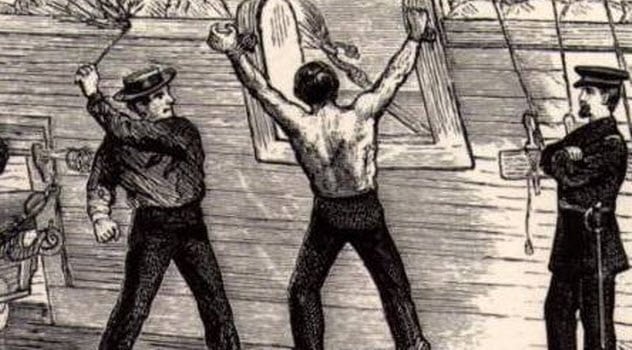
Although we have all heard of flogging, you may not be aware of just how brutal it could be. This was one of the most common punishments in the Royal Navy. Almost any crime could end with this torture.
The condemned would be whipped with a cat-o’-nine-tails, a whip with nine (sometimes) waxed knotted tails. When a sailor was to be flogged, he would be kept in leg irons on the upper deck for a day. This was to give him time to make the cat.
Yup, that’s right. The poor guy would have to make his own instrument of pain. If he chose not to make it or it wasn’t finished in time, the punishment could be increased. Twenty-four hours later, the fun began.
The whole crew would assemble on deck to witness the punishment. Whichever rule the offender had broken would be read aloud from the Articles of War (a list of rules for a ship to follow). The sailor would then be asked if he had anything to say against his sentence.
His shirt would be removed, and he was tied standing to a part of the ship, usually the rigging or the opening of the gangway. The bosun’s mate had the pleasure of inflicting the punishment. He would stand at an arm’s length and lash the man with the strength of a full swing.
By 1750, floggings were restricted to 12 lashes. According to a ship’s doctor, this still left a man’s back “swollen like a pillow, looking black-and-blue.” Sometimes, a captain could get round the 12-lash rule by charging a man with multiple offenses, incurring 12 lashes each. Before this, a sentence could have been issued with hundreds of strikes.
Once a dozen lashes had been carried out, a fresh mate could be called so that the hits wouldn’t lighten up. As the cat began to tear into the skin with each strike, a man’s back could end up looking like a slab of meat from a butcher’s table.[3]
After each lash, the bosun’s mate would run his fingers through the tails to wipe off the blood. Sometimes, when changing to a fresh mate, the next one would be left-handed so as to cross the cuts on the back and tear it up even more.
The pain didn’t end there. Afterward, the man was taken to the ship’s doctor to have his back covered in vinegar-soaked paper or to have salt rubbed into his wounds. This treatment was to stop infection, but it could cause more pain than the actual flogging.
7 Flogging Around The Fleet
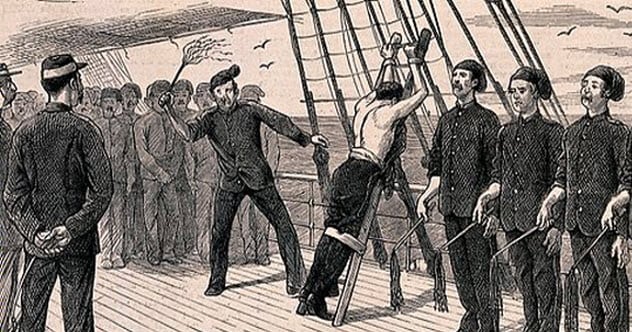
This was much the same as a normal flogging with the cat-o’-nine-tails, but it was more of a show for others to witness—usually when there was a collection of ships nearby in a harbor. The crew member would be tied to a small boat’s mast and lashed by the bosun’s mate.
The boat was then taken to the next ship where that vessel’s mate took his turn lashing the prisoner. This continued through all the ships, hence the term “flogging around the fleet.” For added effect, the boat was sometimes tailed by another small vessel containing a drummer boy to make the whole thing feel even more somber than it already was.[4]
Flogging continued in the Royal Navy until 1881.
6 Cobbed And Firked

You might think that the job of a cook aboard a ship would enable a man to escape punishment for his small mistakes. Not quite. He had his own special medicine to take.
While not as serious as some of the other punishments, a cook could expect to be “cobbed and firked” for misplacing food or allowing it to spoil. This was an unofficial type of flogging done by beating the cook with sand-filled stockings or bung staves of a cask (the wooden panels that make up a barrel).
This was not so much of a pain type of punishment as a humiliation. The culinary criminal was more likely to be stuck “as a boy”—hit on the buttocks instead of anywhere else. No one wanted to hurt the cook so much that it stopped their grub from being served up on time.[5]
5 Child Punishment
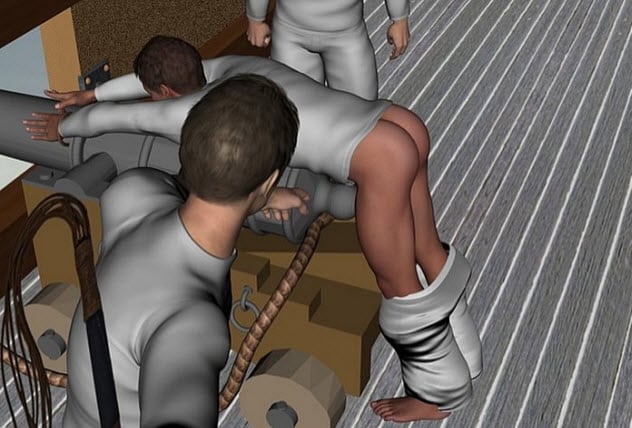
Speaking of “as a boy,” a ship’s crew did not consist only of adult men. Young boys were often employed, usually beginning at the ages of 11 or 12. Unfortunately for them, age was no barrier to corporal punishment. We can see from surviving ships’ logs that roughly one-third of all floggings were perpetrated against children.
At any point in time, all boys under age 19 could receive a caning for minor offenses. Much the same as for the adults, these minor punishments for children went unrecorded. This could lead to daily bullying. In one recorded instance, a captain was noted as having his boys caned every morning. When one boy had the audacity to whimper, “Please, sir,” his punishment was increased.
If the offense required a more serious punishment, a boy would be made to “kiss the gunner’s daughter.” He would be bent over a cannon in front of the rest of the crew, have his trousers dropped, and be struck on the bare behind. Other than it being a more childlike punishment, one reason for this is that the boys usually worked the rigging. Whipping their hands would impair them in this job.
By the mid-19th century, this was done with a “cane or birch.” But before then, a reduced cat (aka “the boys’ pussy”) would be used. This was like a cat-o’-nine-tails but with five whip ends.
On the rare occasions when a boy was sentenced through a court-martial, an adult cat could be used. This happened to poor Valentine Woods in 1813. The 17-year-old lad was sentenced to 60 lashes on his bare posterior for stabbing a crewmate. Come to think of it, maybe Valentine did deserve that one.[6]
4 Running The Gauntlet

One of the worst things you could do in the navy was steal from your shipmates. The punishment shows that it was a hated crime by almost all. To run the gauntlet, an offender would be stripped to the waist and flogged as usual with the “thieves’ cat.” This was a cat-o’-nine-tails with extra knots for bonus hit points.
The offender would then be forced at sword point to walk between two rows of men who all had lengths of knotted rope. Each man had to bash the criminal as hard as possible while he slowly walked past. To stop him from walking too fast, there was also an officer in front of him with a cutlass at his chest. After that, the criminal was flogged some more for good measure.[7]
Although mainly used for thieves, this form of punishment was also used for other crimes such as fraud and sodomy. This resulted in many casualties. After a few noted deaths, running the gauntlet was banned by 1806.
3 Falling Asleep On Watch
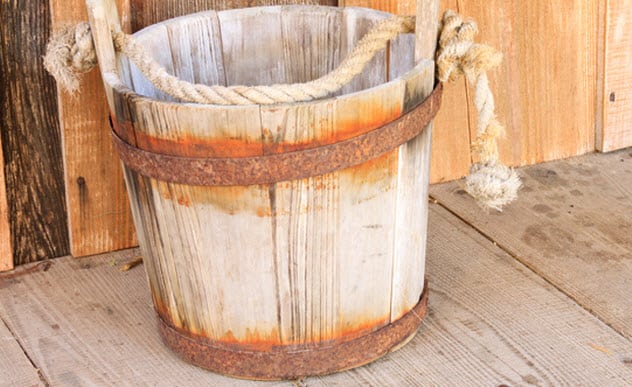
This was an extremely serious offense as being on watch was to guard all the lives aboard a ship. However, life at sea was boring, so falling asleep did happen a lot. If a grave punishment was meted out for the first offense, a ship would have no crew left. As a result, the consequences would escalate for sleepy sailors.
As listed in the Black Book of the Admiralty, the punishments for falling asleep were as follows. For a first offense, something as simple as a bucket of cold seawater would be poured over the offender while others laughed. Not so bad.
The next time, his hands would be tied up and cold water tipped into his shirt. Still nothing to cry about so far.
For taking a third nap on duty, a sailor would be tied to a ship’s mast and be made to hold up heavy objects with his arms stretched out wide. Most often, these objects were cannon chambers. This became quite painful after a while. In addition, the officer in charge was allowed to inflict whatever extra pain he wished.
The fourth punishment put an end to Mr. Sleepybones’s slumbering adventures—mainly because he was dead when it was over. He was put in a basket which was hung from the bowsprit (the pointy mast that sticks out at the front of a ship). He was guarded by an armed sentry who was instructed to kill the offender if he tried to escape. Then he was left to starve to death.
However, the prisoner did have a couple of options. He would be allowed a knife, so there was always the choice to cut his own wrists. Alternatively, he could slice the basket’s rope and drown in the open sea.[8]
2 Hanging From The Yardarm
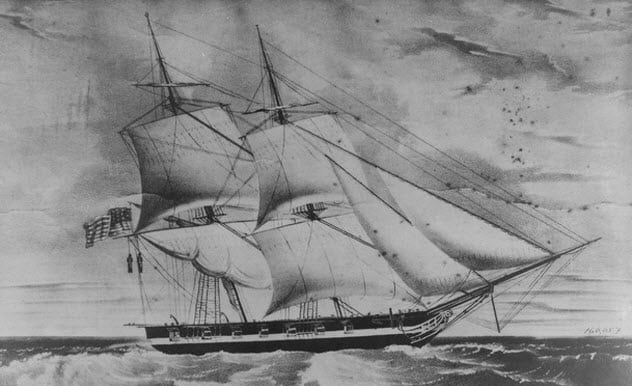
The hanging basket method was not the only means of execution. In the 18th century, such grievous crimes as striking an officer, desertion, or being guilty of “indecent practices” could result in an execution.
By the 1800s, this was more for serious things like mutiny or murder. Whatever the crime, a court-martial could end with the order of a hanging from the yardarm. Unlike the more modern usage of drop hanging in which a prisoner will die instantaneously, a yardarm death was slow and painful.
The condemned man would have his hands and feet tied, and a noose was placed around his neck. The crew stood on deck to watch. A gunshot was the signal for a group of men holding the rope to begin pulling. The prisoner would be “run up the yardarm” and left there to die from strangulation. After an hour, his body was taken down.
This type of execution was last carried out in 1860 after Royal Marine John Dalliger murdered a lieutenant and the commanding officer of the HMS Leven. He had been caught stealing brandy.[9] US ships also used this form of punishment (as pictured above).
1 Keelhauling
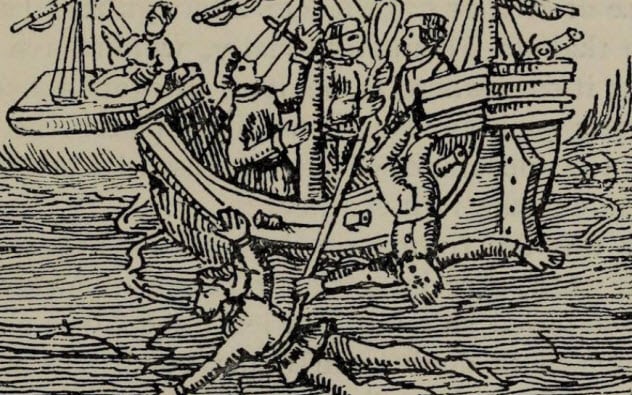
This was possibly the worst punishment during the Age of Sail. Never officially sanctioned by the Royal Navy due to its barbaric cruelty to the condemned, keelhauling was still carried out on numerous occasions before being banned around the year 1720.
The victim would be stripped naked on the deck of a ship in full sight of the rest of the crew. He would have two ropes tied to him. One of them ran underneath the bottom of the ship (the “keel”).
The man would then be hung over the side of the ship, pulled underwater, and hauled along the keel by the second rope until he emerged on the other side. This could be carried out as slowly as the officers in charge wanted or repeated as many times as ordered.
A weight was tied to the man’s legs to make sure that his body was properly in line with the hull. This resulted in many drownings. But if that didn’t kill him, the man had other things to deal with.
Underwater, a ship’s hull (especially a wooden ship) was covered in barnacles. As any child who has slipped on a barnacle-covered rock at the seaside will tell you, they are sharp. Very sharp. Like being dragged along a giant, razor-sharp, cheese grater, the barnacles tore the flesh of the man. If he managed to survive this awful event, he would certainly be scarred for life.[10]
For other bizarre tales about sailing, check out 10 Extremely Dramatic Mutinies From History and 10 Crazy Exploits From The Age Of Sail.








